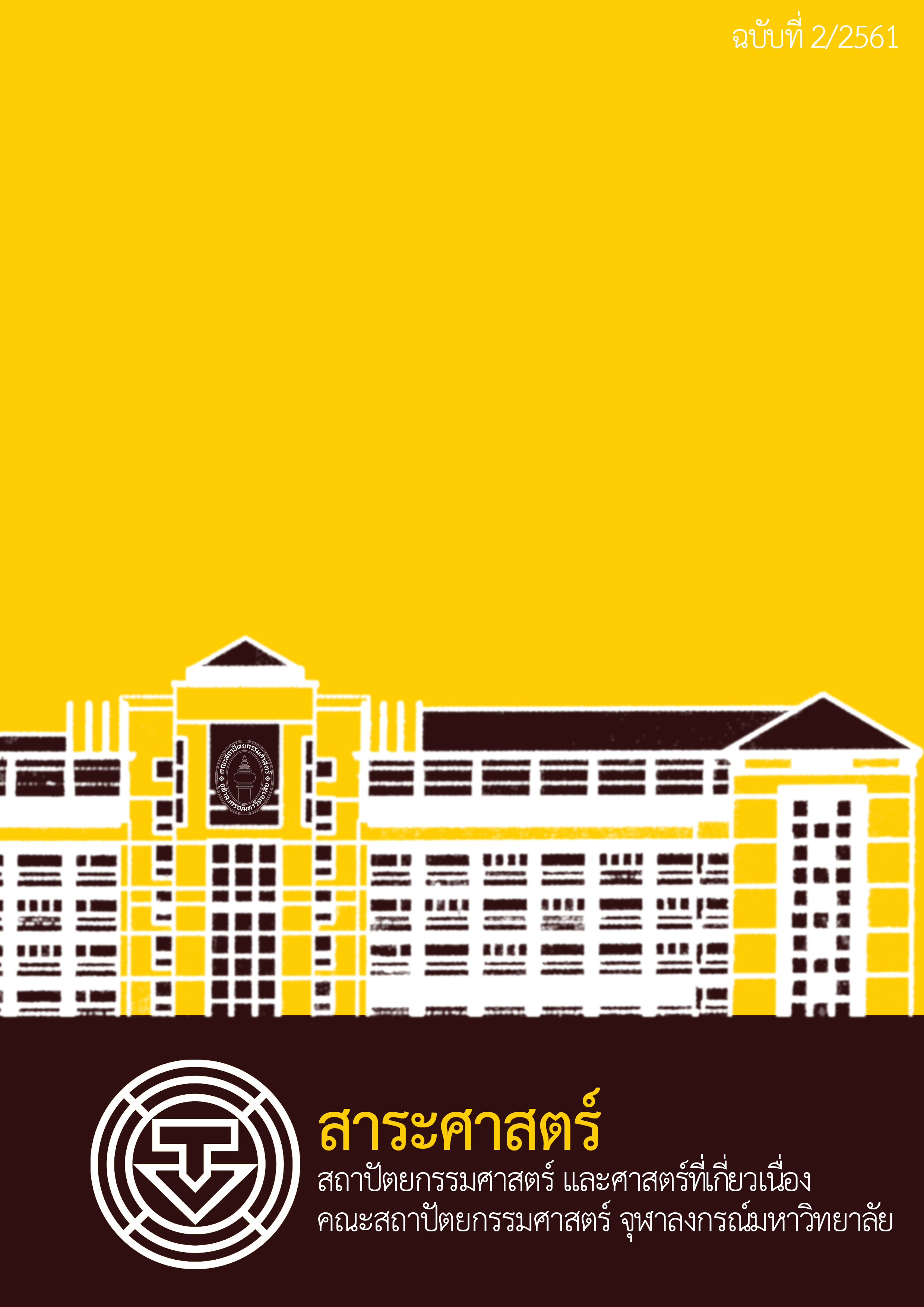การศึกษาสมบัติทางกลของวัสดุไม้เก่า กรณีศึกษา : บ้านพาทยโกศล
Main Article Content
บทคัดย่อ
บทความเรื่อง การศึกษาสมบัติทางกลของวัสดุไม้เก่า เป็นส่วนหนึ่งของวิทยานิพนธ์เรื่องการทดสอบการใช้ไม้เก่า
เพื่อนากลับไปสร้างอาคารใหม่ กรณีศึกษา : บ้านพาทยโกศล โดยมีวัตถุประสงค์ เพื่อศึกษาวิธีการคัดกรองไม้เก่าเพื่อนา
กลับมาใช้ใหม่โดยช่างไม้ และทดสอบไม้เก่า และไม้ใหม่ในด้านการรับแรงรูปแบบต่างๆ ตามชนิดไม้
การทดสอบคุณสมบัติทางกลการรับแรงรูปแบบต่างๆ ของไม้เก่า และไม้ใหม่ตามชนิดของไม้จากอาคารหลังนี้
ประกอบด้วยวิธีการคัดกรองไม้ จากภูมิปัญญาช่างไม้โดยวิธีการเบื้องต้น และการทดสอบวัสดุหลังจากผ่านการคัดกรอง
จากช่างแล้ว นาไม้ไปทดสอบหาค่าสมบัติทางกลของ ไม้เก่าโดยใช้มาตราฐานการทดสอบไม้ หาค่าสมบัติทางกลได้ แก่
แรงอัดของไม้ตั้งฉากกับแนวเสี้ยน และแรงอัดของไม้ขนานกับแนวเสี้ยน วัสดุไม้ที่นามาทดสอบ คือ ส่วนของโครงสร้าง
อาคารเพราะเป็นส่วนที่รับแรงมากที่สุดขั้นตอนแรกในกระบวนการวิจัย ทาการคัดเลือกชิ้นงานจากที่ช่างได้ทาการคัดกรอง แบ่งออกเป็น 2 กลุ่ม คือ กลุ่มทีไม่สามารถนากลับมาใช้งานได้ และ กลุ่มที่สามารถนากลับมาใช้งานได้ จากนั้นตัดชิ้นงานตามขนาดมาตรฐานที่จะทาการทดสอบ โดยแยกไม้ออกเป็น 3 ชนิด ชนิดละ 3 ชิ้นงาน เพื่อการทดสอบหาค่าคุณสมบัติทางกลต่อ 1 แรง โดยใช้เครื่องทดสอบสมบัติทางกล (Universal Testing Machine) หลังจากทดสอบจนถึงจุดวิบัติของ เนื้อไม้จึงทาการบัน
ทึกผล และถ่ายภาพเมื่อทดสอบชิ้นงานจนครบ นาผลทั้งหมดมาตรวจสอบกาลังแรงอัดจากการทดสอบพบว่าการคัดกรองของช่างที่ได้คัดไม้ เมื่อนาไปทดสอบ แรงอัดของไม้ตั้งฉากกับแนวเสี้ยนผล ที่ได้ค่าสมบัติทางกลเฉลี่ย ไม้แดง 13083 ไม้เต็ง 9188 ไม้สัก 4121 Load(kgf) ส่วนไม้ที่ไม่สามารถนากลับมาใช้งานได้ได้ค่าสมบัติทางกลเฉลี่ย ไม้แดง 9254 ไม้เต็ง 1816 ไม้สัก 5722 Load(kgf) แต่พบว่ามีไม้สักอยู่ 1 ชิ้น ที่ให้ค่าสมบัติทางกล 10193 Load(kgf) ซึ่งอยู่ในระดับที่ใช้ได้ ส่วนการทดสอบแรงอัดของไม้ขนานกับแนวเสี้ยน ผลค่าสมบัติทางกลเฉลี่ยไม้แดง 13707 ไม้เต็ง 18618 ไม้สัก 14065 Load(kgf) ส่วนไม้ที่ไม่สามารถนากลับมาใช้งานได้ ได้ค่าสมบัติทางกลเฉลี่ยไม้แดง 9824 ไม้เต็ง 5707 ไม้สัก 9726 Load(kgf) จึงสามารถบ่งชี้ได้ว่าไม้ที่ช่างคัดกรองมาสามารถเชื่อถือได้
Article Details
เอกสารอ้างอิง
มาตราฐานสมาคมวิศวกรรมสถานแห่งประเทศไทยในพระบรมราชูปถัมภ์ วสท. 1002 : มาตราฐานสำหรับอาคารไม้
มาตราฐานงานช่าง มยธ.(ท) 201-2541 มาตราฐานวิธีการทดสอบหาค่าแรงอัดในแนวตั้งฉากเสี้ยนของไม้ กรมโยธาธิการ กระทรวงมหาดไทย
มาตราฐานงานช่าง มยธ.(ท) 202-2541 มาตราฐานวิธีการทดสอบหาค่าแรงอัดในแนวขนานเสี้ยนของไม้ กรมโยธาธิการ กระทรวงมหาดไทย
มาตราฐานผลิตภัณฑ์อุตสาหกรรม มอก. 424-2530 ไม้แปรรูป : สำหรับงานก่อสร้างทั่วไป


